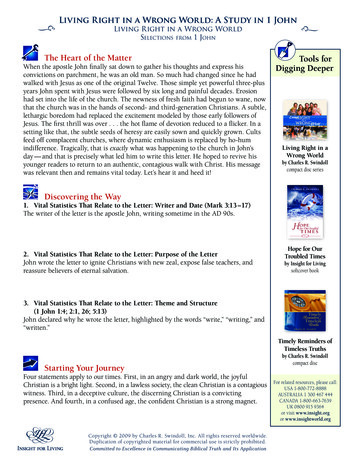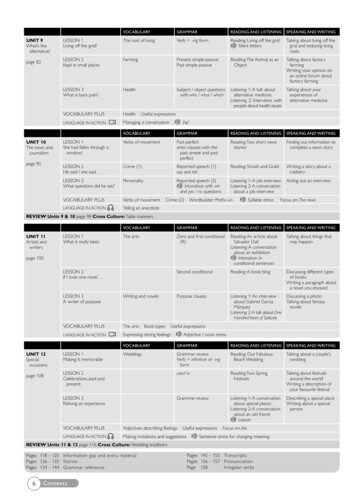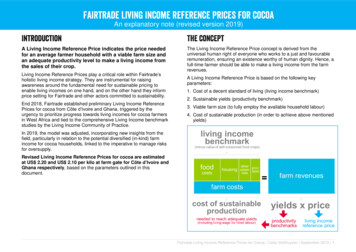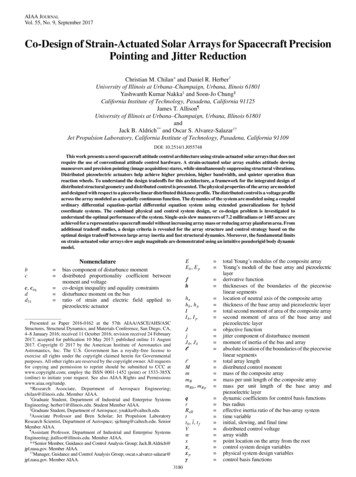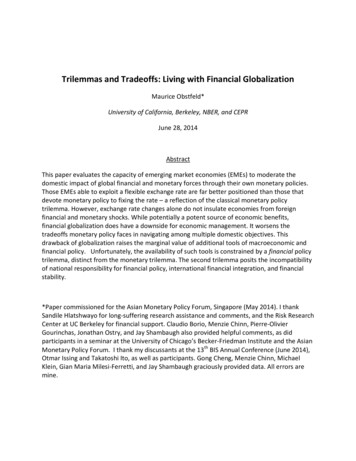
Transcription
Trilemmas and Tradeoffs: Living with Financial GlobalizationMaurice Obstfeld*University of California, Berkeley, NBER, and CEPRJune 28, 2014AbstractThis paper evaluates the capacity of emerging market economies (EMEs) to moderate thedomestic impact of global financial and monetary forces through their own monetary policies.Those EMEs able to exploit a flexible exchange rate are far better positioned than those thatdevote monetary policy to fixing the rate – a reflection of the classical monetary policytrilemma. However, exchange rate changes alone do not insulate economies from foreignfinancial and monetary shocks. While potentially a potent source of economic benefits,financial globalization does have a downside for economic management. It worsens thetradeoffs monetary policy faces in navigating among multiple domestic objectives. Thisdrawback of globalization raises the marginal value of additional tools of macroeconomic andfinancial policy. Unfortunately, the availability of such tools is constrained by a financial policytrilemma, distinct from the monetary trilemma. The second trilemma posits the incompatibilityof national responsibility for financial policy, international financial integration, and financialstability.*Paper commissioned for the Asian Monetary Policy Forum, Singapore (May 2014). I thankSandile Hlatshwayo for long-suffering research assistance and comments, and the Risk ResearchCenter at UC Berkeley for financial support. Claudio Borio, Menzie Chinn, Pierre-OlivierGourinchas, Jonathan Ostry, and Jay Shambaugh also provided helpful comments, as didparticipants in a seminar at the University of Chicago’s Becker-Friedman Institute and the AsianMonetary Policy Forum. I thank my discussants at the 13th BIS Annual Conference (June 2014),Otmar Issing and Takatoshi Ito, as well as participants. Gong Cheng, Menzie Chinn, MichaelKlein, Gian Maria Milesi-Ferretti, and Jay Shambaugh graciously provided data. All errors aremine.
IntroductionThis paper evaluates the capacity of emerging market economies (EMEs) to moderatethe domestic impact of global financial and monetary forces through their own monetarypolicies. I present a case that those EMEs able to exploit a flexible exchange rate are far betterpositioned than those that devote monetary policy to fixing the rate – a reflection of theclassical monetary policy trilemma. Indeed, this ability was critically important in EMEs’ widelysuccessful response to the Global Financial Crisis (GFC) of 2007-2009.However, exchange rate changes alone do not insulate economies from foreign financialand monetary developments. While potentially a potent source of economic benefits, financialglobalization does have a downside for economic management. It worsens the tradeoffsmonetary policy faces in navigating among multiple domestic objectives. This drawback ofglobalization raises the marginal value of additional tools of macroeconomic and financialpolicy.Unfortunately, the availability of such tools is constrained by a financial policy trilemma,distinct from the monetary trilemma. The second trilemma posits the incompatibility ofnational responsibility for financial policy, international financial integration, and financialstability. It therefore impedes effective national prudential policies when capital markets areopen to cross-border transactions.1My argument that independent monetary policy is feasible for financially open EMEs,but limited in what it can achieve, takes a middle ground between more extreme positions in1See Schoenmaker (2013) for a broad survey.1
the debate about monetary independence in open economies. On one side, Woodford (2010, p.14) concludes: “I find it difficult to construct scenarios under which globalization wouldinterfere in any substantial way with the ability of domestic monetary policy to maintain controlover the dynamics of inflation.” His pre-GFC analysis, however, leaves aside financial-marketimperfections and views inflation targeting as the only objective of monetary control. On theother side, Rey (2013) argues that the monetary trilemma really is a dilemma, because EMEscan exercise no monetary autonomy from United States policy (or the global financial cycle)unless they impose capital controls.The outline of this paper is as follows. First, I present an overview of the capital flowproblem for EMEs. Then, I review mechanisms through which monetary policies and thefinancial cycle in advanced economies, especially in the U.S., are transmitted to EMEs. Onepotent mechanism works through interest rate linkages, but financial conditions can alsomigrate through other channels. Thus, there is a global financial cycle that does not coincidewith global monetary-policy shifts (Borio 2012; Bruno and Shin 2013; Rey 2013), and exchangerate changes alone do not fully offset its effects. The next section sets out empirical evidenceon interest rate independence in EMEs, adding to the existing literature by analyzing long-terminterest rates. The results leave no doubt that countries that do not peg their exchange ratesexercise considerable monetary autonomy at the short end of the term structure; but longterm interest rates are more highly correlated across countries, with little regard for theexchange-rate regime.2
In the penultimate section, I describe the relationship between policy trilemmas andtradeoffs in open economies. I present my argument that the fundamental problem for openEMEs is not ineffective monetary policy per se. The problem is a more difficult tradeoff amongmultiple objectives, the result of a shortage of reliable policy instruments for attaining thoseobjectives simultaneously. 2 A brief final section outlines future research directions and alsodescribes how some limited initiatives in international policy cooperation might soften theharsh tradeoffs that EMEs now face.OverviewSince the nineteenth century, emerging and frontier regions have been subject to theebb and flow of lending from richer countries. Even in the last century, powerful lending cyclesbuffeted those regions in the 1920s, in the 1970s through the early 1980s, in the early 1990s, inthe middle 2000s, and after 2009.With the development of emerging financial markets and the general expansion ofglobal finance, however, recent decades have revealed some new patterns. First, manyemerging countries that Nurkse (1954) ruled out as portfolio investment destinations based ontheir colonial history now receive such flows. Perhaps history is not always destiny after all.Second, even emerging economies with persistent current account surpluses – including severalAsian economies – may experience gross capital inflow surges, the result of rich-countryportfolio shifts in favor of emerging assets. Where these portfolio demands are accommodatedthrough the home central bank’s intervention, the financial inflows finance foreign reserve2In a closely related spirit, Filardo, Genberg, and Hofmann (2014) propose a “three-pillar” policy strategy foremerging economies – one that navigates among price stability, financial stability, and exchange rate goals.3
increases. Where the central bank instead allows currency appreciation, net private claims byforeigners still rise, albeit gradually over time, as a result of a reduced current account balance.3China’s case shows how both mechanisms can operate at once. Whether the central bankintervenes or not, domestic financial conditions are affected immediately, though theexpansionary effect is probably bigger when intervention occurs and causes an increase in thedomestic money supply and domestic bank credit. 4Capital inflow surges can cause a range of dislocations – not the least of which is tocreate a range of vulnerabilities to subsequent capital-flow reversals. After the GFC, industrialcountries, their recoveries slowed by effects of private and public debt overhang, relied oncontinuing monetary stimulus in the forms of ultra-low policy interest rates (sometimescoupled with forward guidance) and unconventional quantitative measures. In general,however, the EMEs – at least those that avoided big debt run-ups5 – had suffered less in thecrisis. With economies growing more briskly than those of advanced countries, these EMEs didnot require abnormally accommodative monetary policy settings. Currencies, bonds, equities,and real estate appreciated because of the resulting global portfolio shift into EME assets.3In a pair of classic contributions, Calvo, Leiderman, and Reinhart (1993,1996) linked net emerging market capitalinflow surges to monetary ease in the advanced countries. Their theme remains highly relevant, of course, and isthe central focus of this paper. For documentation on gross capital flow surges and reversals, see Cowan, DeGregorio, Micco, and Neilson (2008), Forbes and Warnock (2012), and Broner, Didier, Erce, and Schmukler (2013).On long-term cycles in capital flows, see Bacha and Díaz-Alejandro (1982), Eichengreen (1991), and Obstfeld andTaylor (2004). Of course, the pattern of net capital flows remains puzzling, as discussed by Prasad, Rajan, andSubramanian (2007) and Gourinchas and Jeanne (2013). On the importance of financing conditions as reflected ingross capital flows, see Borio and Disyatat (2011).4For some suggestive evidence that this is the case, and that net private capital inflows are likely to create morefinancial fragility in economies with less flexible exchange-rate regimes, see Magud, Reinhart, and Vesperoni(2014). The theoretical perspective I sketch later in this paper suggests, however, that a more nuancedunderstanding would come from studying the impacts of gross inflows, as analyzed by some of the referenceslisted in the previous footnote.5See Gourinchas and Obstfeld (2012).4
Appreciation contributed to financial stability (as well as competitiveness) concerns, andcountries that resisted exchange-rate change through intervention saw greater pressure ondomestic asset prices, on domestic credit growth, and on general product price levels. Thosepressures have now left EMEs more vulnerable to a reversal of global financial flows.Clearly, then, EMEs have an interest in tempering the effects of global portfolio shifts,especially when the sequence is capital feast followed by capital famine. How can EMEs usetheir macroeconomic tools to do so? Astute observers have long known that in principlemonetary policy is vital, but cannot furnish the sole to response to capital inflow surges. Shortlyafter the Tequila crisis of two decades ago, for example, Calvo, Leiderman and Reinhart (1996,p. 137) wrote:[T]he countries that have been the most successful in managing capital flows haveimplemented a comprehensive policy package and not relied on a single instrument. Atthe outset of the surge in inflows, these countries reacted by treating inflows astemporary and resisted a nominal exchange rate appreciation; the foreign exchangeintervention was mostly sterilized. As the inflows persisted, sterilization efforts werescaled back and the domestic currency was allowed to appreciate. To moderate theextent of the real appreciation and prevent the economy from overheating, fiscal policywas tightened. To moderate the volume of the inflows and lengthen their maturities,exchange rate flexibility was increased and measures to curb inflows wereimplemented.A less productive policy mix has consisted of persistent sterilization (which keepsshort-term interest rates comparatively high), heavy intervention in the foreignexchange market (which results in little short-run exchange rate uncertainty) and nocontrols on short-term capital movements. All of these policies have tended to provideespecially strong incentives for short-term capital inflows.5
Subsequent research and experience suggested, however, that for some countries, thepreceding approach was difficult to implement in practice during the 1990s. Perhaps mostimportantly, currency mismatch and the need for an easily verifiable nominal anchorsometimes imparted a strong policy bias toward exchange-rate stability in EMEs, therebyconstraining monetary policy (Hausmann, Panizza, and Stein 2001; Calvo and Reinhart 2002). Inthe presence of fixed or highly managed exchange rates, a number of policy failures set thestage for the EME crises of the late 1990s.More recently, the position of EMEs has evolved considerably. As noted above,international financial flows have increased in scale, particularly in gross terms, driven insignificant part by international banking flows. At the same time domestic financial systemshave expanded and deepened. While for EMEs these changes are not as extreme as for theadvanced countries, they are still a highly significant and leave EMEs more exposed to shifts inglobal financial-market sentiment. For example, a big sell-off of domestic assets by foreigninvestors is likely to induce a significant exchange rate change before enough buyers comeforward to restore market equilibrium. EME corporates and banks increasingly issue bondsoffshore, and these foreign-currency liabilities – not captured in standard, residence-based netinternational investment position data – are a potential source of currency mismatch, as well asdirect exposure to foreign financing conditions (Turner 2014; Shin 2013).One manifestation of global financial linkages is the importance of cross-border credit,both in local and foreign currency (see Borio, McCauley, and McGuire 2011). Figure 1 shows the6
ratio of cross-border to domestic bank credit for five regions, as measured in the BIS GlobalLiquidity Indicators. Three regularities stand out. First, apart from the Asia-Pacific grouping(which mixes advanced and emerging economies), cross-border credit is very significantcompared to domestic bank credit – currently in the 10 to 20 percent range for the other fourregions. Second, in all regions, the ratio of cross-border to domestic credit covaries positivelywith the global credit boom of the mid-2000s and the subsequent collapse – a reflection of thegross financial flows that helped fuel the GFC. Finally, the cross-border bank credit ratio fallssecularly in Latin America and emerging Europe, from a very high level at the start of themillennium to a level roughly on the same order as for the U.S. and the euro area. In part,declining reliance on cross-border bank lending reflects domestic financial deepening; in part, itreflects retrenchment in banks’ global activities and growth in bond finance after the GFC.While perhaps reduced compared to its level in 2000, considerable exposure to global bankingfluctuations remains for many EMEs, and evidence indicates that net cross-border debt flowsfuel domestic credit growth. 6 Moreover, increasing EME recourse to non-bank funding sourceshas created new exposures, some not even visible in residence-based data on gross externalliabilities, such as the Lane and Milesi-Ferretti (2007) data for selected countries shown inFigure 2. 7Counteracting the increased vulnerabilities are some policy and institutionalenhancements. 8 Over time, EMEs have shifted their gross liability positions away from debt in6Locational banking data such as these (based on the residence principle) may well understate banking exposure,as the head offices of domestic affiliates are likely to divert funding in a crisis. See Cetorelli and Goldberg (2011).Lane and McQuade (2014) document a link between net cross-border debt flows and domestic credit growth.7For this figure I exclude tax havens as well as all countries with GDP below 2 billion in 2012.8See Obstfeld (2014) for a more detailed survey and discussion.7
the direction of equity instruments (portfolio equity and FDI). In this respect, internationalfinancial integration promotes international risk sharing and therefore can be a stabilizingfactor. Figures 3 and 4 illustrate the recent dramatic shift of external liabilities toward equity(see also Lane and Shambaugh 2010 and Prasad 2012). 9 Currency depreciation automaticallydevalues this portion of external liabilities; but even the remaining external and domestic debtis increasingly denominated in domestic currency (Lane and Shambaugh 2010; Miyajima,Mohanty, and Chan 2012; Turner 2012). The growth of domestic bond markets – mostadvanced among the EMEs in Asia, where corporates are significant players alongsidegovernments – has been an important supporting factor. Moving from a nominal exchangerate anchor to some alternative (often a managed float within the context of an inflation target)has paid dividends for many EMEs, both in providing generally moderate inflation and inrelieving the government of the need to defend a definite line in the sand with monetary policyor reserves. The second dividend has generally reduced the incidence of foreign exchangecrises, in part by freeing foreign exchange reserves for purposes other than defense of anexchange rate target. 10 Of course, more reliably moderate inflation itself has helped topromote domestic-currency denomination of domestic and foreign liabilities.9In general, the picture in emerging Europe (where some countries are in the euro area) is more mixed and not asfavorable to foreign equity finance. The data in the figures of course reflect stock market price fluctuations, but thetrends are still clear. Broadly speaking, if one starts in 1970, the data describe a J shape. Prior to gaining access toprivate lending markets in the 1970s, developing countries relied primarily on FDI for private foreign financing.Access to debt finance allowed a fall in the FDI share. Only much later did portfolio equity inflows becomeimportant. The United States is shown in Figure 3 for the purpose of comparison. A caveat to Figures 3 and 4 is thatthe Lane and Milesi-Ferretti data, which are residence-based, do not capture offshore bond issuance by domesticnationals.10Ghosh, Ostry, and Qureshi (2014) discuss evidence on the susceptibility of hard and adjustable pegs to crisis. Ifforeign exchange reserves are not dedicated to defense of the exchange rate, more of them can be used in lenderof-last resort operations in support of domestic entities with short-term foreign-currency liabilities. On the relationbetween reserve use during the GFC and economic performance, see Dominguez, Hashimoto, and Ito (2012).8
A more effective approach to financial oversight, typically including a macro-prudentialcomponent, has supplemented these macroeconomic regime changes. Many EMEs, especiallyin Asia, have accumulated large stocks of foreign exchange reserves that allow the domesticmonetary authority to play a lender-of-last-resort role for financial institutions with short-termforeign-current liabilities. Market perceptions that authorities are able and willing to play thatrole, as many did quite effectively during the GFC, are a stabilizing factor for capital flows.Moreover, large precautionary reserve holdings are complemented by a higher level of capitalaccount restrictions than in advanced economies; Bussière et al. (2014) present evidence on thestabilizing effects of reserve stocks and the use of capital-account measures. Figure 5, which isborrowed from their paper, shows that while advanced and advancing countries alike haveliberalized cross-border financial flows over the past three decades, the developing/emerginggroup has on average liberalized less and accumulated more international reserves in theprocess. 11To what degree have the preceding structural changes insulated EMEs from monetaryshifts and financial cycles in advanced countries? Both during the accommodative phase ofadvanced-country monetary policies following the GFC, and more lately, as markets have cometo anticipate the tapering of accommodation in the United States, EMEs showed their habitualreluctance to let exchange rates bear the full adjustment burden. Indeed, some of the verystructural changes cited as enhancements for EME stability could have downsides. Domesticbond markets, if dominated by foreign asset managers and lacking big domestic players such aspension funds and insurance companies, could be quite volatile, with long-term bond returns11Figure 5 uses the Chinn and Ito (2006) measure of capital-account openness.9
tightly linked to those in advanced-country markets (Shin 2013). 12 Moreover, if foreign holdersof EME-currency bonds hedge the currency risk with counterparts in the issuing country, thispotentially creates a currency mismatch: the domestic counterparts have incurred a foreigncurrency liability which (leaving aside the associated forward claim to a domestic-currencypayment from the bond holders) is equivalent to foreign-currency bond issuance (He andMcCauley 2013).To diagnose and assess the threat from ongoing potential vulnerabilities, it is importantto consider carefully the transmission mechanisms between advanced and EME financialmarkets, and whether there are effective tools that EMEs can use to cope with financial shocksfrom abroad.Transmission mechanismsIn the early 1970s, inflation surged worldwide. One obvious mechanism drivingsynchronized global inflation was the system of fixed exchange rates central to the BrettonWoods system, under which all countries pegged to the U.S. dollar (thereby surrenderingmonetary autonomy) while the U.S. retained monetary discretion (thereby dominating globalmonetary conditions). Both relatively loose monetary policy in the U.S., together with a hugespeculative portfolio shift away from the dollar in anticipation of its debasement, led to bigincreases in foreign exchange reserves and money supplies outside of the United States.12Highly diversified fund managers might have little incentive to focus on particular countries’ economicfundamentals, as argued by Calvo and Mendoza (2000).10
A major motivation for the subsequent move to generally floating exchange rates (atleast among industrial economies) was therefore to regain control over domestic inflation. Yet,industrial-country inflation rates did not diverge. They rose in concert in the 1970s, continuingeven after the abandonment of fixed exchange rates, and largely fell starting in the followingdecade. Ciccarelli and Mojon (2010) document a powerful common component in 22 OECDcountries’ inflation rates over the 1960-2008 period. EME inflation rates remained higher insome countries throughout the 1980s, notably in Latin America, but those rates also convergeddownward starting in the 1990s. While trend inflation rates still differ across countries, thecross-country range of variation has become relatively small. The proposition that countries cancontrol their inflation rates over the long term is widely accepted, and observed inflationconvergence is regarded as a country- or currency-union-specific phenomenon reflectingsynchronized improvements in economic literacy and economic governance. 13The degree of national control over short- to medium-term macro developments(including but not restricted to price-level dynamics) is more controversial. When countries’financial markets are linked, even imperfectly, macroeconomic models incorporating realisticgood- or asset-market frictions imply that policy and other shocks will be transmitted to tradingpartners, possibly causing unwanted spillovers even when currency exchange rates float freely.Two related questions have been especially prominent in recent debate about the scope forindependent and effective monetary policy by EMEs. First, can EMEs offset shifts in advanced13McKinnon (1982) hypothesized that even with floating exchange rates, a high degree of substitutability amongthe major industrial-country currencies made national inflation depend on world money-supply growth. If this viewwere right, even long-term inflation would be out of the hands of any single central bank. There is little theoreticalor empirical support for McKinnon’s “global monetarist” hypothesis, although some recent authors have usedglobal monetary aggregates as proxy variables for global liquidity conditions. An example of the empirical critiquesis Wallace (1984).11
country monetary policies – most importantly U.S. monetary policy – through their ownmonetary instruments? Second, in the face of a global financial cycle that is in principle distinctfrom monetary policy cycles – but which also causes portfolio shifts with respect to EME assets– what scope do EMEs have for an effective policy response? Some recent analysis has beenpessimistic. Perhaps most provocatively, Rey (2013) argues that EMEs have essentially no roomfor monetary policy that diverges from U.S. conditions: the monetary trilemma is really adilemma, with independent monetary policy possible if and only if capital markets aresegmented from the outside world. On this view, global rather than national liquidity iscentral.14To assess such arguments, it is useful to review some main mechanisms of transmissionof foreign monetary and financial shocks to EME financial markets. 15Direct interest rate linkages. Perhaps most fundamental in a world of integratedfinancial markets are direct interest rate linkages between countries, which reflect forces ofcross-border arbitrage on rates of return. Conventional monetary policy manipulates a shortinterest rate directly but has effects at all maturities, and these effects induce portfolio shiftsinto foreign assets. In turn, those portfolio shifts generally affect exchange rates, asset prices,capital accounts, and macroeconomic policies abroad.If an emerging country fixes its exchange rate against the currency of a centralcountry (for example, the United States), then it has no choice but to match the latter’s choice14For recent assessments of the concept of global liquidity, see Borio, McCauley, and McGuire (2011), Committeeon the Global Financial System (2011), Gourinchas (2012), and Landau (2014).15For complementary discussions see Caruana (2012), He and McCauley (2013), and McCauley, McGuire, andSushko (2014).12
of policy interest rate. Moreover, provided the exchange rate peg is credibly permanent, riskfree nominal interest rates at all maturities must match those of the U.S. Thus, U.S. monetarypolicy is passively imported, in accord with the monetary trilemma.More generally, exchange-rate flexibility of various types and degrees will alter theinternational transmission of interest rates. If e is the domestic price of the U.S. dollar, i theshort-term policy rate of interest, and ρ a foreign-currency risk premium, then domestic andU.S. short rates will be linked by an interest-parity relationship of the form:𝑖𝑡 𝑖𝑡𝑈𝑆 𝐸𝑡 𝑒𝑡 1 𝑒𝑡 𝜌𝑡.Above, the risk premium ρ might reflect the covariance between the depreciation rate ofdomestic currency and a stochastic discount factor for domestic currency payments. Now,changes in the U.S. interest rate need not feed one-for-one into 𝑖𝑡 , depending on the behaviorof the exchange rate and the risk premium. For example, if the EME central bank holds itsinterest rate absolutely constant when the U.S. cuts its interest rate, and the risk premium doesnot change, then foreign currency will appreciate sharply (a fall in the price of dollars, 𝑒𝑡 ),overshooting its expected future value so as to maintain interest parity. The EME central bankcan still set the policy interest rate it prefers, but a sharp exchange rate change may well haveeffects on its economy that strongly influence the monetary policy response .A powerful inhibition to allowing full exchange rate adjustment in such circumstances isthe negative effect on domestic export competitiveness. The EME central bank may interveneto dampen appreciation, thereby (typically) acquiring international reserves and allowing ajump in the net private capital inflow into its economy. In turn, an increased money supply will13
likely cause a rise in domestic bank lending. Sterilization of the monetary effects (if somewhateffective) could raise longer term rates at home and (if carried out on a large enough scale)lower them in the U.S., eliciting further pressure through the capital account. The carry-tradedynamics may be reinforced by the perception that the central bank is merely slowing aninevitable appreciation of its currency. The probable effect, in this case, therefore remainstransmission of U.S. monetary ease.Since sterilized foreign exchange intervention is often limited in its effectiveness,stronger efforts to limit currency appreciation are likely to enhance the correlation between thedomestic and U.S. policy interest rates. Even when there is no intervention, consequential twoway private gross capital flows could occur, such as increased U.S. bank loans to the EMEcountry, the proceeds of which are deposited in banks abroad. This increase in cross-bordercredit could well have an impact on domestic financial conditions (as suggested in partialequilibrium models such as Bruno and Shin 2013); I return to this issue below. Even a fullyfloating exchange rate cannot provide full insulation from the expansion of gross foreign assetsand liabilities.Further international linkages occur through the longer-term interest rates set in bondmarkets. These rates affect activity in key economic sectors and drive real wealth throughasset-valuation effects. As in the case of short-term interest rates, direct arbitrage betweennational markets links long-term rates and exchange rates, but long-term rates reflect not onlyshort-term rates, but expected future short rates as well as risk factors. To the extent thatmonetary policy works through its effect on longer-term interest rates, such as mortgage rates14
or corporate borrowing rates, stronger international linkages between long-term rates couldhamper monetary autonomy, in the sense of requiring sharper changes in short-term rates (andperhaps in forward guidance on those rates) to achieve a given desired result.To make the discussion more precise, consider the simplest two-period example. Then(2
Trilemmas and Tradeoffs: Living with Financial Globalization Maurice Obstfeld* University of California, Berkeley, NBER, and CEPR June 28, 2014 . Abstract This paper evaluates the capacity of emerging market economies (EMEs) to moderate the domestic impact of global financial




